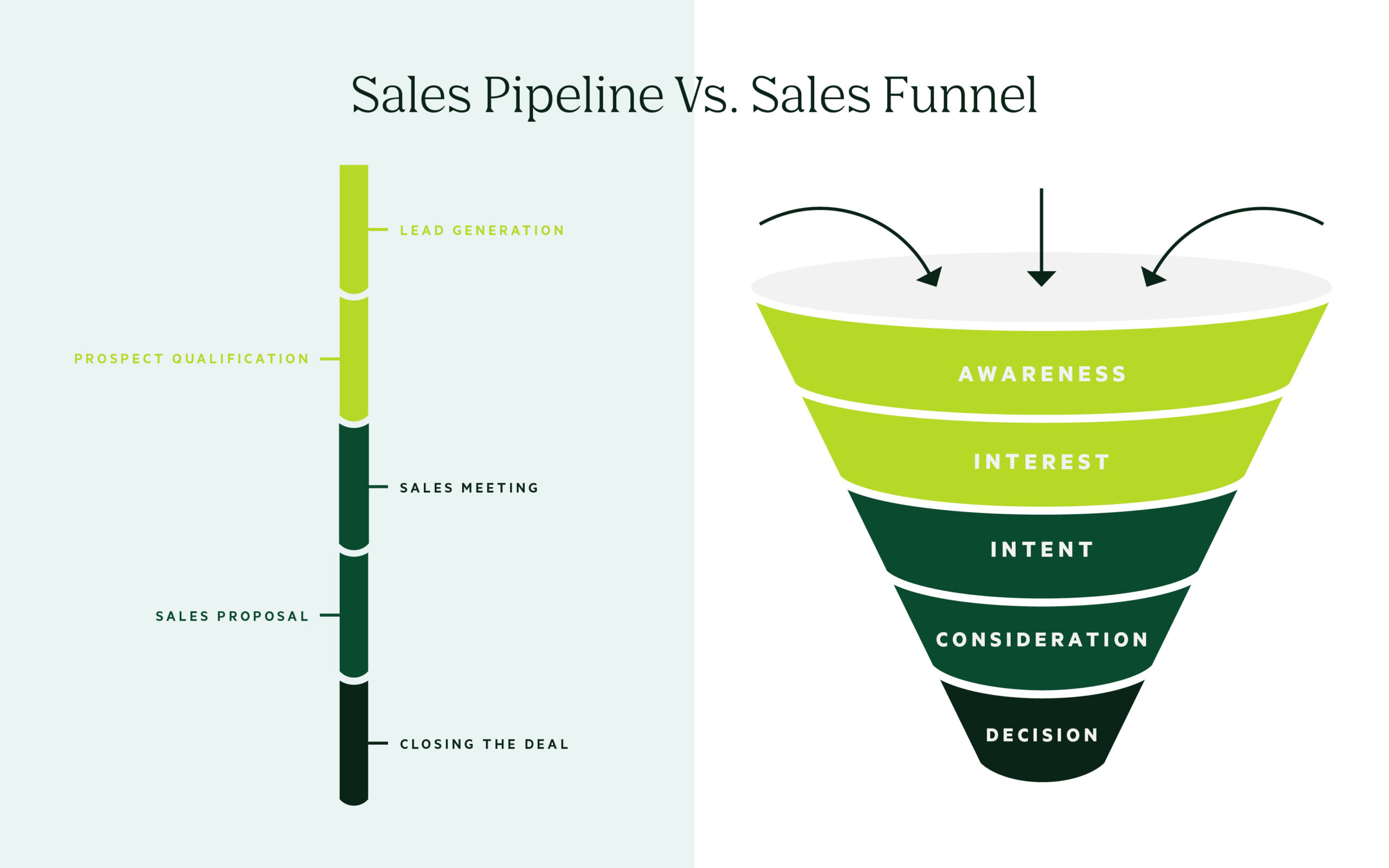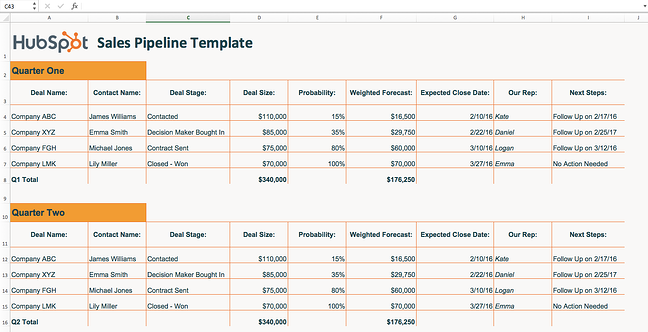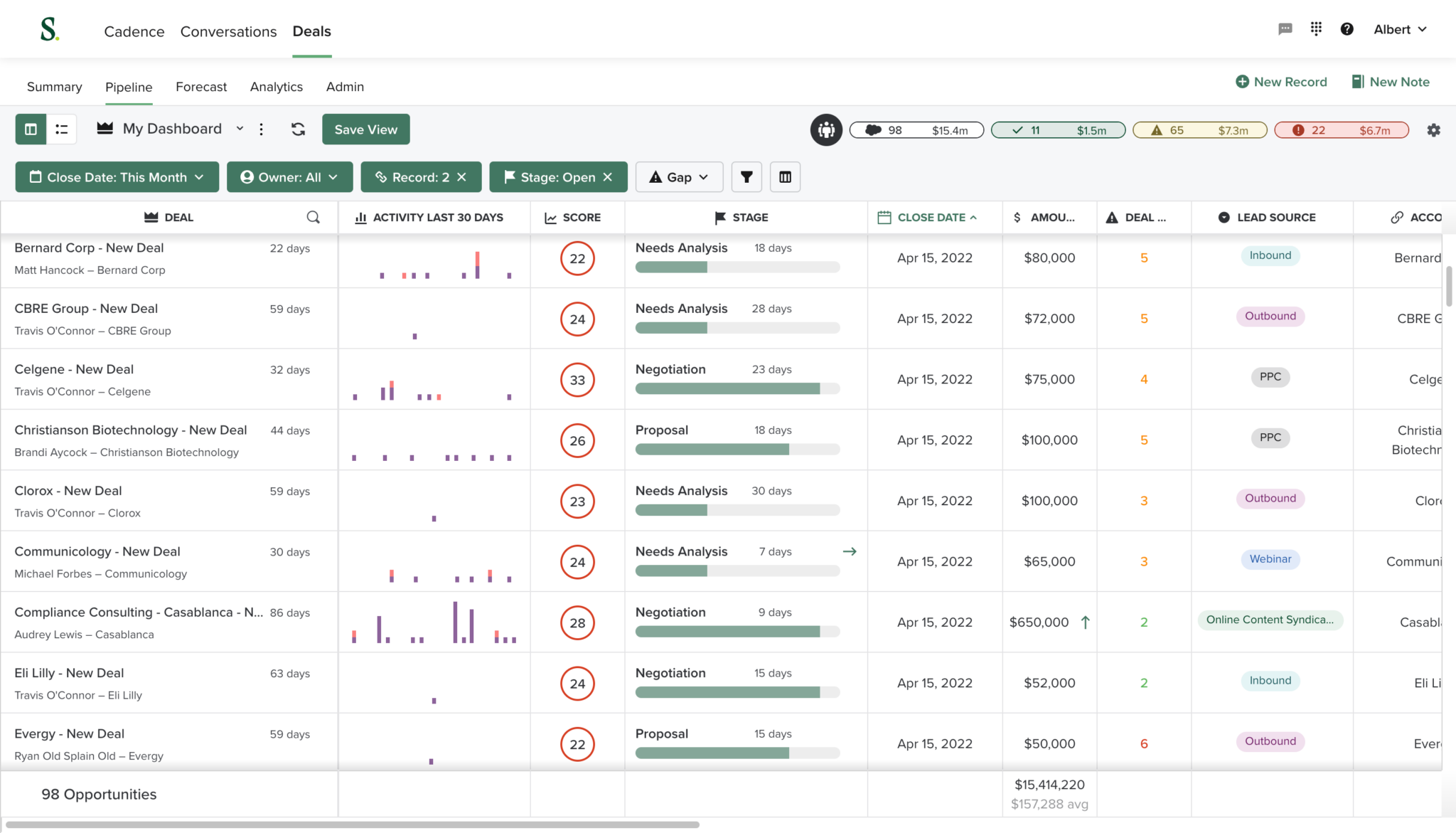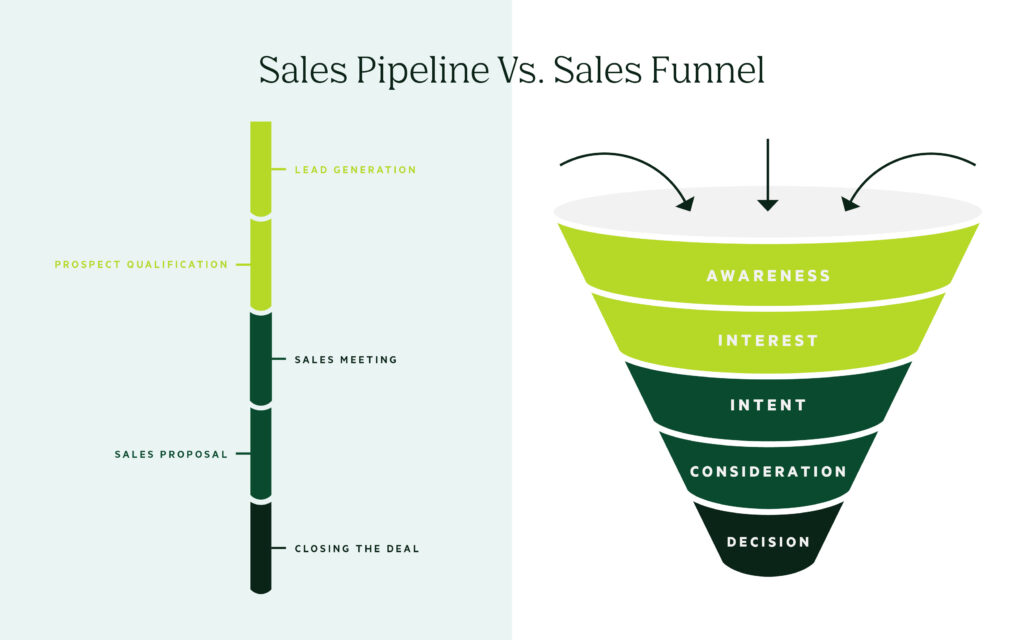What Is a Sales Pipeline?
A sales pipeline is a visual representation of your sales process. Salespeople and their managers rely on the sales pipeline to prioritize accounts, keep deals moving, and forecast revenue.
Companies typically visualize their pipeline using different stages. They then layer in data such as expected close date, deal size, and sales rep to get a fuller picture. Without this, you may lack valuable insights about how effective your sales process is and where your deals are at any given time.
Below, we’ll dive deeper into the sales pipeline -including how it affects your business, its various stages, and how a pipeline differs from the sales funnel (another phrase that salespeople love).
Sales Pipeline vs. Sales Funnel
The sales pipeline and sales funnel are both vital ways to visualize two distinctly different functions within the sales process.

The sales pipeline visualizes the buyer’s journey from a salesperson’s perspective, tracking open deals from start to close.
Meanwhile, the sales funnel visualizes the buyer’s journey from the prospect’s perspective. The funnel shape represents how qualified leads follow the sales process as they transition from the top to the bottom of the funnel. Download templates to map your buyer’s journey.
For greater insights into both perspectives, teams use software to build sales pipelines and sales funnel reports.
Sales pipeline reports illustrate activity, deal strength, and volume. Meanwhile, funnel reports track conversion rates, providing data on lead generation effectiveness and funnel leakage.
When sales teams use both sales pipelines and funnels, they gain valuable input on their current strategies.
How the Sales Pipeline Can Make or Break Your Business
Sales leaders use the pipeline to keep reps on track to achieve their quota and more importantly, make predictions on how much revenue they can likely realize.
If sales representatives don’t keep pipeline data updated throughout the sales process, you could reach the end of the quarter and miss the revenue goal by thousands or even millions of dollars. Since every prospect moves through the sales process differently, sales leaders and sales management need a full picture of the pipeline to forecast which deals will close in a given timeframe.
A sales pipeline can also keep you from losing leads. Every sales rep is guilty of forgetting to follow up every now and then. With the help of automation and workflow tools, sales reps can break down the various stages of the pipeline into small, manageable tasks. Not only does this help reps stay on top of day-to-day selling, but it keeps winnable deals from slipping through the cracks.
Companies who use sales pipeline technology have a much easier time ensuring accuracy and improving sales strategies, increasing rep accountability, and gaining greater visibility into the sales cycle. Plus, the top tools use insights powered by AI and engagement data. For example, the technology can surface deal gaps and predict the deals that are the most engaged and likely to close.
Sales pipeline stages are unique to every business. How you define your sales pipeline stages and the length of time buyers spend in each will depend on your buyer’s journey, but here’s an example with five different stages of the pipeline.
Lead Generation
Lead generation is how potential customers discover your business. Marketing efforts such as social media, landing pages, case studies, and webinars target an ideal customer (i.e. individuals or businesses who fit your buyer persona) and deepen interest. With enough interest, these ideal customers will enter the sales process as new leads. Email marketing is then used to nurture the leads.
One of the most effective methods of lead generation is sending one-to-one emails at scale. A multi-channel approach with several personalized steps will bring a solid number of prospects into the sales funnel. A sales engagement platform makes it simple with proven cadence templates and integrations with the top prospecting tools.
Prospect Qualification
Prospect qualification assesses whether a potential customer is a good fit for a business.
Many companies use a sales qualification framework, like MEDDICC or BANT, to evaluate opportunities and eliminate time spent on dead-end deals and decision makers. Elements of this framework should be included with your pipeline to help accurately gauge deal strength.
During the qualification stage, log all activities and use your call recording software so you can reference these details as the opportunity moves through the sales pipeline. The best pipeline management software automatically syncs with your CRM and allows you to take action right from the pipeline.
Sales Meeting
With prospects who may be eager to purchase, you are now ready to move to the next stage of the pipeline: the sales meeting. Here, reps advance the deal by asking for a meeting or demonstration. The goal of a sales meeting isn’t simply to sell, but to evaluate the interest level of the prospect, re-align on pain points, and communicate with decision-makers.
Sales efforts up until this point can easily be derailed if you’re not properly aligned with the buyer, don’t have the right people in the room for the meeting, or if you’ve failed to build a business case. That’s where sales managers should step in with coaching to prevent a failed meeting.
Sales Proposal
If the meeting went well, you should now prioritize follow up with a sales proposal. With the information you’ve gained and logged in your sales engagement platform, your proposal should skillfully address your prospect’s top concerns and pain points.
Sales managers can drill into opportunities to see factors that could signal an issue. For example, if a prospect has not responded to an email within seven days, it could be a red flag.
Closing the Deal
The final stage of the sales pipeline is closing the deal to tranform a prospect into a paying customer. If the previous stages went well, the prospect agrees to purchase. If not, the rep closes the account.
A closed-won deal may mark the end of the pipeline, but it signifies the start of the customer relationship and the uphill challenge of customer retention.
14% of customers drop businesses because they feel their complaints aren’t heard.
– Semrush
It’s critical, then, that reps ensure a seamlessly handoff new accounts to the implementation or customer success team by automating communication and ensuring all activities are logged and notes are complete. This will ensure that all parties are on the same page with the customer’s needs and complaints, which will lead to a positive experience from the start.
Sales Pipeline Templates
Sales pipeline templates allow businesses to create and track their pipeline in a spreadsheet or software.
If you are tracking your pipeline in a CRM or using a generic template, you’ll likely want to transition to sales engagement software, which is usually much easier to use and offers greater insights. That said, templates are a great starting point for newcomers who are still growing their customer base.
They offer a simple way to follow basic pipeline metrics. Templates can record deal data such as points of contact, assigned reps, lead scores, forecast revenues, and deal stages.
Keep in mind that pipelines differ from industry to industry. You can adjust the following template examples to reflect your business or use Salesloft to build a pipeline dashboard.
Sales Pipeline Templates for Startups

(Source)
In addition to their CRM platform, Hubspot offers a free sales pipeline template. Perfect for startups and new businesses, this template has a clean design, easy customization options, and automatic calculations for younger industries still getting their feet wet.
Sales Pipeline Template for Small Businesses to Enterprise Companies

(Source)
Using a complete sales engagement platform like Salesloft is the best-in-class experience for sales pipeline management. You can design your own templates using real-time data or use one of the standard sales pipeline templates for small businesses. With Salesloft, templates leave room for more precise tracking, including the probability of deal closing, new actions, and collaborative notes.
Strengthen Your Sales Pipeline With Salesloft
The sales pipeline visualizes your team’s unique sales process. With the right tools and a proven template, sales teams can increase pipeline generation and effectively manage sales opportunities and forecasts.
Salesloft offers dynamic pipeline management backed by effective deal tracking and in-depth sales analytics.
Follow every stage of the pipeline on detailed dashboards. Glean insights only available through comprehensive buyer engagement data. Track deal progress, conversion rates, deal cycle length, average touches per account, and more.


